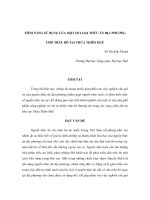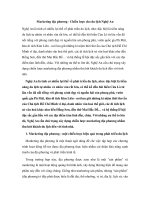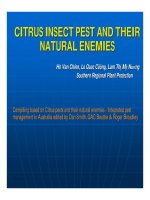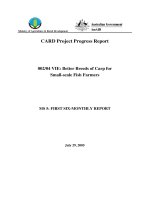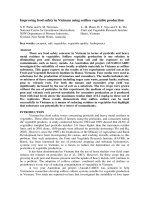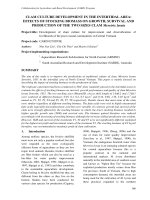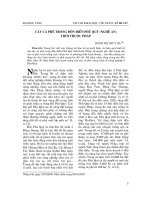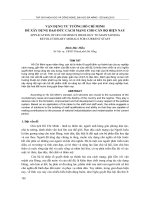Báo cáo nghiên cứu khoa học: " WATER RESOURCE MANAGEMENT IN HO CHI MINH CITY, VIETNAM: AN OVERVIEW" doc
Bạn đang xem bản rút gọn của tài liệu. Xem và tải ngay bản đầy đủ của tài liệu tại đây (393.92 KB, 13 trang )
TẠP CHÍ PHÁT TRIỂN KH&CN, TẬP 12, SỐ 02 - 2009
Bản quyền thuộc ĐHQG-HCM Trang 51
WATER RESOURCE MANAGEMENT IN HO CHI MINH CITY, VIETNAM:
AN OVERVIEW
Vo Le Phu
University of Technology, VNU-HCM
(Manuscript Received on November 13
th
, 2008, Manuscript Revised February27
th
, 2009)
ABSTRACT: Water is a resource needed in all aspects of life and is regarded as a
decisive factor for Earth’s ecosystems survival. However, water resource has also become a
limiting factor of social and economic development. For cities of the developing world, water
is increasingly playing a vital role in sustainable urban development. Since economic reform
known as “Doi Moi” (renovation) in 1986, Ho Chi Minh City, Vietnam, has undergone the
rapid growth of urbanization and industrialization. As a result, the City has experienced
critical environmental challenges in which water use and management have placed constraints
on its sustainable development. These striking challenges include water shortage, pollution
and depletion of surface and groundwater sources. The underlying reasons can be attributed
to inadequate management practices. The purpose of this paper is to provide an overview of
rapid urbanization and growing water resource problems. It also examines the management
practices and analyze the root causes of water resource issues in the course of sustainable
development.
Keywords: Ho Chi Minh City, pollution, sustainable development, urbanization, water
resources management.
Abbreviations: SAWACO - Sai Gon Water Supply Company; MARD - Ministry of
Agricultural & Rural Development; MONRE – Ministry of Natural Resources & Environment;
DONRE - Department of Natural Resources & Environment.
1.BACKGROUND TO HO CHI MINH CITY
Ho Chi Minh City (HCMC), formerly known as Sai Gon, was founded in 1698. After
reunification in 1975, Sai Gon was renamed as HCMC. It was originally a small fishing village
known as Prey Nokor (means “forest city” or “forest land”). The area that the city now
occupies was originally marsh and swamp land, and was inhabited by Khmer people for
centuries before the arrival of the first Vietnamese settlers in 1698 [1].
Since economic reform known as “Doi Moi” (renovation) in 1986, it has experienced fast
industrial and urbanization. Increasingly, HCMC has become an important hub for political,
economic, cultural activities and the heart of the Mekong Delta region [2] & [3].
The renovation policy triggered the so-called ‘industrialization and modernisation’ process
which created momentum and impetus for social transformation and radical economic
development. Accordingly, this process is the driving force of rapid economic and urban
growth of HCMC, bringing both opportunities and challenges.
In token of challenges, HCMC’s water sources are coming under stress, an anomaly given
that on an annual basis it has abundant water supplies. The major water stresses include water
shortage, degradation and depletion of the surface and aquifer sources. This paper will provide
an overview of these urban water problems, and examine the existing constraints of
management practices.
Science & Technology Development, Vol 12, No.02 - 2009
Trang 52 Bản quyền thuộc ĐHQG-HCM
1.1.Precipitation
Yearly average rainfall is about 2,000 mm. The rainy season accounts for 80-85% of
yearly rainfall. However, the rainfall is not distributed evenly, and tends to increase in the
southwest-northeast axis. Most central districts and northern districts usually have higher
rainfall than districts in the south and southwest. [4].
Seasonal fluctuations in annual precipitation result in variation of water quantity and
quality in Vietnam’s major urban centers, particularly in HCMC. Generally, Vietnam’s rainfall
is highly distributed in a short period of the year and causing water shortages and floods [5].
1.2.Urbanization trend
The demography and the population pattern of HCMC have dramatically changed. Its
population has doubled over 25 years from 2.5 million in 1975 to 5.17 million people in 2000
[6]. During the last two decades, rapid urbanization is concomitant with its burgeoning
population. By 2004, the urban population figure has accelerated to 6.1 million people,
accounting for 7% of the country’s population in which 5.2 million inhabitants live in urban
Districts and 0.9 million people in outlying Districts. Due to the rapid population growth, the
density pattern steadily increases up to 2,987 inhabitants per km
2
in mid 2005 [7]. The urban
population growth is depicted in the Figure 1.
0
1
2
3
4
5
6
7
8
9
1970 1975 1980 1985 1990 1995 2000 2005 2010
Year
Population (m illion)
Figure 1. Evolution of urban population growth in HCMC, 1975-2010
Source: this was compiled by the author from different cited sources.
Urbanization has promoted economic and social changes as urban centers are the hub of a
nation’s economic growth, culture, innovation, knowledge and political power. It is claimed
that most Asian countries have benefited from urbanization in terms of employment, lifestyles,
welfare, social structures and institutions [8]. Additionally, Biswas (2000) noted that the large
urban centers of the developing world contribute to 60% of total national economic growth [9].
Urbanization, on the other hand, is responsible for a wide range of environmental
consequences, including water resource deterioration, inadequate drinking water and
sanitation, coupled with health problems from water-related diseases, air pollution and solid
waste management [9] & [10]. Not surprisingly, most governments of the developing world
have failed to cope with the high rate of urbanization concomitant urban water issues. Most
TẠP CHÍ PHÁT TRIỂN KH&CN, TẬP 12, SỐ 02 - 2009
Bản quyền thuộc ĐHQG-HCM Trang 53
importantly, they are unable to develop a good governance scheme, management capacity and
efficient financial resources to provide urban dwellers basic water-related services [11] & [12].
In the Southeast Asian perspective, dense population and massive urbanization are the
fundamental reasons contributing to growing stresses on the management of natural resources
and have overwhelmed the capacities of water policy [13].
By 2010, HCMC’s population is projected to be around 8-10 million people taking into
account of the un-registered City’s population [3] & [14]. This will result in pressures on
securing adequate water sources, ensuring basic human needs and managing water resources
will pose challenges on the City’s urban planners, managers and water professionals as well as
burdens on urban water infrastructure.
2.WATER RESOURCES AND URBAN HYDROLOGY
HCMC is geographically situated in a well-watered region with abundant swamps and
marshes. It has been maintained by abundant surface and subsurface water. There are three
major water sources are used for supply in HCMC: surface water (from the Dong Nai and Sai
Gon river system), groundwater and rainwater [14] & [15].
2.1.Groundwater sources
Apart from surface supplies, aquifer sources have been increasingly exploited for domestic
and industrial purposes, accounting for 30-40% of water demand in HCMC. Aquifers in
HCMC are categorized into 5 layers, namely, Holocene, Pleistocene, Upper- Pliocene, Lower-
Pliocene and Mezozoi, in which the 3 latter aquifer layers are important sources for water
supply [17].
The exploitation rate of groundwater was accelerated to meet all domestic and industrial
uses. There were more than 95,828 wells in 1999 and about 150,000 bores in 2003, equivalent
to 530,000 m
3
/day, of which 100,000 m
3
/day is withdrawn for domestic use [17], [18] & [19].
However, the aquifer source has been haphazardly exploited at an alarming level, evidenced
by the abstraction volume, 520,000 m
3/
day, which surpassed the sustainable limits [6]. The
over pumping of groundwater has jeopardised the available quantity of aquifer sources. The
groundwater decline is evidenced by salt intrusion being observed in monitoring wells [6] &
[20].
2.2.Rainwater
Rainwater is currently harvested by residents in coastal districts: Can Gio, Nha Be and
District 7. It can be argued that rainwater is abundant and should be considered as an
alternative source for HCMC as the rainy season accounts for 80-85% of the annual rainfall.
However, it is not easy to harvest and store in the context of HCMC due to highly investment
and large facility required [17]. The utilization of rainwater is only small scale in most of
households in Can Gio district because of no freshwater sources and distribution network [16].
3.OVERVIEW OF URBAN WATER ISSUES
Despite the fact that it is located in a humid tropical region with abundant water resources,
HCMC has recently been facing an acute water stress resulting from rapid industrialization and
urbanization. It is claimed that water shortage is a striking issue of economic development in
the Southeast Asian region [21] & [22].
Science & Technology Development, Vol 12, No.02 - 2009
Trang 54 Bản quyền thuộc ĐHQG-HCM
3.1.Water use and demand
Total water demand for domestic and industrial purposes in 2006 was 1.75 million m
3
, and
was estimated to be 3.6 million m
3
in 2020 [23]. The major water sectors are industries,
agriculture, households and services. The largest component of HCMC’s water supply sources
comes from upstream sources of the Sai Gon-Dong Nai river system. The ratio of river and
groundwater contribution in HCMC’s water supply before and after 2003 is presented in
Figure 2.
The coverage of water supply in HCMC increased from 52% in 1997 [24] to 84% in 2004
[25]. However, the proportion of unaccounted flow is relatively high in comparison with other
Asian cities as presented in Table 1. However, only 76% of urban dwellers are provided with
clean water by SAWACO, 10.5 % of suburban residents have access to clean water from the
UNICEF program. The real figure remains unmeasured because a large number of citizens in
outlying Districts still lack access to clean and safe drinking water.
Table 1. Water Supply Service in Selected Southeast Asian Cities
Bangkok
*
HCMC Jakarta
Kuala
Lumpur
Manila
Production/population
(m
3
/d/c)
0.53 0.37 0.27 0.44 0.56
Water coverage (%) 82 84 (52) 51 (27) 100 (100) 58 (67)
Sewerage access (%) n.a 12 2 80 7
Water availability
(hours/day)
24 18 (24) 22 (18) 24 (24) 21 (17)
Consumption/capita
(L/capita/ day)
265 167 (136) 77 (135) 132 (146) 127 (202)
Sources: (Andrews and Yñiguez, 2004) and (*) (McIntosh and Yñiguez, 1997).
Notes:
(a)
Data in brackets ( ) are sourced in 1997;
(b)
n.a = not available
According to the projected population growth, municipal water consumption is projected
to be 1.1 million and 1.6 million m
3
in 2010 and 2020 respectively [17]. This growing demand
will lead to more abstraction of water from the Sai Gon-Dong Nai river system. Therefore, the
City’s government at all levels will face major challenges and management constraints on
conserving aquifers at sustainable levels and protecting the main river system from pollution
and degradation.
3.2.Urban inundation and water shortage
HCMC typifies a paradox of water issues and “stand with its feet in the water” [26]. On
the one hand, there is too much water during the wet weather resulting in inundation in many
urban districts. Due to historical and geographical location, many parts of urbanized areas are
subject to flooding in the rainy season from May to October. The inundation condition is
seriously exacerbated by tidal surges in low-lying urban districts that faced serious
waterlogging and inundation after heavy storm events combined with tidal surges [6].
In contrast, suburban dwellers lack access to clean water supply or inadequate provision
with clean water [27]. The reasons for water shortage include insufficient water sources and
inadequate supply networks. District 7 and Nha Be District have suffered an ever water
shortage in the dry season 2006. These Districts’ residents have paid approximately $US 2/m
3
TẠP CHÍ PHÁT TRIỂN KH&CN, TẬP 12, SỐ 02 - 2009
Bản quyền thuộc ĐHQG-HCM Trang 55
of clean water. The situation is severely aggravated for the two coastal districts of Can Gio and
Nha Be where it is hard for clean drinking water to reach residential areas [28]. In addition, the
proportion of residents with access to clean drinking water in outlying Districts is low. Among
5 outlying suburban Districts, Binh Chanh and Nha Be had only 10.64% and 22.14% of people
have access to clean water.
Proportion of Water Supply in HCMC
0
10
20
30
40
50
60
Groundwater Dong Nai river Sai Gon river
Percentage (%)
Before 2003
After 2003
Figure 2. Proportion of water supply sources in HCMC [8]
3.3.Groundwater depletion and pollution
Groundwater is one of three main sources of water supply for social development in
HCMC. This aquifer source will continue to play a crucial role in the city’s water supply in the
future [14]. However, the alarming diminution of groundwater is becoming apparent to water
managers. The results of a 5 year monitoring project between 2001 and June 2006 indicate that
the annual average drawdown of water table in HCMC is 2-3 m [29]. Table 2 shows the annual
drawdown of water table in high bores density [15] and the withdrawal of groundwater over
time in HCMC is presented in Figure 3.
The total recharge volume is only one-third of the extraction rate due to accelerated
growth of impermeable urban surfaces and hydrological changes associated with rapid
urbanization [29]. The overabstraction from aquifer sources has resulted in further lowering of
the water table in suburban districts. The water table in Thu Duc and Go Vap, outlying
Districts, has dropped 4-5 m during the last 5 years [18]. The root causes of this incidence are
complex and intertwining. Inadequate water supply services and poor performance of
infrastructure are among such reasons [14]. It can be said that insufficient water supply has
resulted in an enormous number of private wells having been bored over urban districts to
satisfy many domestic purposes.
Nevertheless, the quality of groundwater is also being worsened from both point and non-
point sources. Tran (2001) stressed that the management and protection of aquifers is a
pressing task for HCMC [30]. He also claimed that the quality of groundwater is threatened by
major contaminant sources, including industrial wastewater impoundment, septic tank
systems, leachate from landfills and polluted water wells. In addition, the presence of several
contaminants was identified in shallow aquifers [31].
Additionally, salt intrusion and the fall in water table are observed in some areas. In 2002,
there were 2,359 wells were unable used due to salt intrusion [15]. It is concluded that the
Science & Technology Development, Vol 12, No.02 - 2009
Trang 56 Bản quyền thuộc ĐHQG-HCM
rapid expansion of urban areas, industrial zones associated with over abstraction are the causes
of groundwater depletion and quality degradation [20].
3.4.Pollution of water sources
HCMC is ironically a hotspot area of environmental issues. Including water pollution and
unsustainable urban habitats [21] & [26]. It is the home of about 30,000 small and medium
scale enterprises and more than 800 large scale factories from industrial parks [6]. However,
most of them are not equipped with any wastewater treatment facilities [16]. In addition, it is
estimated that industrial wastewater effluent accounting for 20-30% of the total flows in
Vietnam’s river systems. The major industrial contributions to water pollution are oil refining,
chemical and food processing industries [32] & [33].
Table 2. Drawdown of water table in monitoring stations in HCMC
Groundwater table (m) Aquifer Year
Binh Chanh
Dist.
Binh Tan
Dist.
Phu Nhuan
Dist.
District
11
District
12
2000 -2.69 -2.61 6.76 -5.27 4.85
2004 -5.6 -7.8 1.23 -7.96 3.8
Total drawdown 2.91 5.19 5.53 2.69 1.05
Pleistocene
Annual drawdown 0.73 1.3 1.38 0.67 0.26
2000 -8.18 -9.25 -11.58 -15.79 -7.71
2004 -14.99 -18.57 -22.56 -23.67 -19.26
Total drawdown 6.81 9.32 10.98 7.88 11.55
Upper
Pliocene
Annual drawdown 1.7 2.33 2.75 1.97 2.89
2000 -14.36 -8.94 -12.49 -15.85 -8.5
2004 -29.75 -19.01 -23.12 -28.77 -19.9
Total drawdown 15.39 10.07 10.63 12.92 11.4
Lower
Pliocene
Annual drawdown 3.85 2.52 2.66 3.23 2.85
The decline of water table was caused by industrial and domestic activities in areas: Binh
Hung (Binh Chanh district), Tan Tao (Binh Tan district- newly formed district), Tan Son Nhat
(Phu Nhuan district), Phu Tho (District 11) and Tan Chanh Hiep (District 12).
Source: [15]
3.4.1.Pollution of river basins
Pollution of water sources is also increasing in many rivers in and around HCMC by
untreated wastewater from municipal and industrial activities [16] & [33]. It was estimated
that about 200,000m
3
of industrial wastewater, 17,000m
3
of hospital effluent discharged into
the Sai Gon-Dong Nai river daily [34] & [35]. This amount of wastewater comes only from
industrial activities located along this river system. However, Environmental Management
Division of DONRE identified that only 40% of this wastewater is treated [35]. The figure of
pollution was aggravated starkly as over 50 tonnes of dead fish were found in the upstream of
the Dong Nai river in April 2000 [16].
TẠP CHÍ PHÁT TRIỂN KH&CN, TẬP 12, SỐ 02 - 2009
Bản quyền thuộc ĐHQG-HCM Trang 57
The Sai Gon-Dong Nai river system not only supplies with water, but is also a conveyor of
wastewater [18]. An increase in pollution incidence resulted in a recent urgent response of the
City’s government controlling and protecting water quality of the Sai Gon from pollution [36].
3.4.2.Pollution of urban canal system
More than half of canal systems in HCMC are high density population and industrial
polluting areas. Unfortunately, domestic sewage and industrial wastewater are directly
released into watercourses and canal systems without treatment or with inadequate treatment
[16] & [26].
The Tan Hoa-Lo Gom, Nhieu Loc-Thi Nghe, Tau Hu-Ben Nghe and Kenh Doi-Kenh Te
canals receive daily about 700,000m
3
of municipal and industrial effluent with high levels of
BOD, COD and heavy metals [6] & [26], well above Vietnamese standard levels [16]. This
poses health threats to the inhabitants settled along this canal system [37]. DONRE noted that
all HCMC’s rivers and canals are heavily polluted by organic wastes and coliform, particularly
in the dry season. The situation is likely to accelerate because of the rapid industrial growth
and inadequate control mechanisms [20].
Figure 3. Groundwater extraction over time in HCMC [18]
Furthermore, the situation of canal systems is increasingly aggravated during the wet
weather as the canals receive additional contaminated flows from urban and agricultural
runoff. Not surprisingly, high concentrations of PCBs, DDT and heavy metals were found in
canal sediments [33] & [38].
3.5.Institutional and Legal Frameworks of Water Resources Management Practices
Since 1993, the Vietnam government has introduced an overarching Law on Environment
Protection (which was revised in 2005), standards on air and water quality, decrees on
environmental fines and enforcement, and on the implementation of environmental impact
assessment, as well as circulating, directives on environmental protection [21].
For the management of water resources, the most important institutional framework is the
Law on Water Resources (LWR), which was enacted in May 1998, and became effective in
1999 [32] & [39]. The LWR establishes effective institutions and instruments for the
comprehensive management practices of water resources. The objective of the LWR is to
provide for the management, protection, exploitation and use of water resources and to protect,
Science & Technology Development, Vol 12, No.02 - 2009
Trang 58 Bản quyền thuộc ĐHQG-HCM
combat and overcome the harmful effects of water. In addition, Article 58 of the LWR
describes the responsibility of government for the management of water resources, and MARD
is the government representative to perform the role of water resources management [39].
After 2002, the main function in the management of water resources in MARD was
abolished and taken over by the new Ministry of Natural Resources & Environment
(MONRE). Within MONRE, the Department of Water Resource Management (DWRM) has
been formed to carry out the state management of water resources. However, the service
function of irrigation and rural water supply still remains with MARD [37] & [39].
4.THE ROOT CAUSES OF WATER ISSUES IN HO CHI MINH CITY
It is widely argued that the rapid urban expansion in the developing world has exceeded
the capabilities of the government management practices of water resources in terms of
efficiency, equity and sustainability [11]. Therefore, the future major water challenges in cities
of developing nations include the shrinkage of water sources, arising from increased water
quality deterioration due to improper planning, inadequate management practices and the lack
of political involvement [11]. Importantly, urban managers in developing countries often
neglect their responsibilities for environmental concerns [40] & [41]:
In most cities, poorer groups’ lack of piped water supplies is not the result of a shortage of
fresh water resources but the result of governments’ refusal to give a higher priority to water
supply … A failure of governance underlies most environmental problems [40] (p. 382).
Within the context of HCMC, the causes the City’s water resource problems are rooted in
inadequate institutional frameworks of the urban sector, inappropriate institutional
arrangements and insufficient mechanisms in the water sector. The underlying causes of any
environmental concerns should be analyzed in accordance with the existing social
development conditions and the management practices of local governments at all levels.
Firstly, over-abstraction of groundwater has sprung from the two major causes. The
insufficient water supply network has resulted in an increasing number of dug wells over
urban districts. The local government at all levels failed to control wells which have been
bored haphazardly. There are more than 200,000 tube wells throughout the City supplying for
domestic and industrial purposes [42]. In fact the real number of private wells in HCMC could
be triple the reported figure [37]. These wells have caused a decline groundwater table has
now evident in the outlying districts, Thu Duc and Go Vap [18]. In addition, the degradation of
water quality and depletion of groundwater can be attributed to rapid urbanization coupled
with the increase in urban impervious surfaces. This causes a reduction in recharge and natural
replenishment [31]. The underlying reason is that the rapid urban expansion has overwhelmed
the limited management capacities and existing resources of the City’s government.
Secondly, the deterioration of water quality in surface water resources stems from
institutional weakness. Weak enforcement of law against environmental violation from
industries is one example of such inadequate institutions [16] & [22]. Water pollution
upstream of the Dong Nai-Sai Gon river can be attributed to the lack of coordination between
HCMC DONRE and its counterparts in neighbouring provinces evident in the lack of
horizontal cooperation or overlapping responsibility across government agencies and
departments in HCMC [16]. This causes confusion to many industries and leads to
unpleasantness and avoidance rather than fear or compliance from industries. In addition,
poorly trained staff and inconsistent implementation of regulations are also additional factors
of the management constraints.
TẠP CHÍ PHÁT TRIỂN KH&CN, TẬP 12, SỐ 02 - 2009
Bản quyền thuộc ĐHQG-HCM Trang 59
Thirdly, the inundation in the wet weather stems not only from topographical conditions
but also from the unbridled expansion of many urban areas in the last two decades. The rapid
expansion of urban boundaries has led to the level of canals, waterways and receiving waters
which act as regulators and retention facilities during the high peak of rainfalls. The number of
canals being filled up has accelerated throughout the city, particularly in outlying Districts. In
June 2006, the total area of filled canals was 2,157 ha, and the city still has 105 inundated sites
[43].
To most urban planners view urbanization as ‘cementization’ of urban area surfaces. It is
argued that the replacement of the natural drainage canals for the concrete drainage pipe
should be considered deliberately within the context of urban drainage and hydrology. Thus, it
is hard to disagree that inadequate knowledge on environmental matters associated with
economic development of local governments is a common characteristic of many developing
nations [44]. Not surprisingly, this will result in policy failures. Government practices in urban
planning lag behind the rapid degree of urban expansion. Thus, a number of consequences are
inevitable, including changes in urban surface, hydrology and flow patterns and erosion
associated with heavy rain events.
Additionally, HCMC’s environmental regulatory system is the traditional ‘command-and-
control’-based system. Like other cities in the Southeast Asian region, a state-driven and top-
down approach has long been applied to urban environmental challenges [45]. This traditional
approach seems to be unsuccessful in dealing with the ubiquitous urban environmental issues
in HCMC. More importantly, the combination of laws and subordinate decrees and regulations
itself creates the traditional environmental regulatory system, ‘command-and-control’. This
system fails in developing countries because standards can be set, but are hard to enforce; fines
and punishments can be stipulated, but they are not easy to implement in the real face of
political involvement [21].
Furthermore, it is common that Asian nations usually set up a short term horizon for water
source plans. A long term design plan of 50 or 100 years would be better to secure water for
human needs rather than a 10-year design vision [46]. This is one of the stark challenges in
water policy development and planning to keep up with rapid changes occurring in economic
activities. In addition, O’Rourke (2004) claims that the lack of political power and technical
resource of environmental authorities in the developing world results in weak enforcement of
compliance with environmental regulations. Consequently, the policy and planning is not
resilient enough to respond to emerging trends.
5.CONCLUSION
HCMC has faced with striking water source issues, including pollution, depletion and
degradation. As a developing city, it is seeking to advance approaches to the management of
water resources which raise more questions than answers. Such questions include to what
extent the existing water policy is sustaining the balance of water resource protection during
the process of ‘industrialization and modernisation”? To what extent is the City intensively
polluting and depleting water resources when it industrialises and urbanizes? How can the City
deal with increased stresses and burdens on water resource management in the pursuit of social
and economic development coupled with the rapid trend of urban expansion in a sustainable
way?
Water is undoubtedly one of the key natural resources to underpin sustainable
development of HCMC. Urban sustainable development has been deployed as a fashionable
slogan of many government sectors and authorities. However, HCMC’s authorities lack a
Science & Technology Development, Vol 12, No.02 - 2009
Trang 60 Bản quyền thuộc ĐHQG-HCM
strategic formulation of water resources management. An increase in water demand, pollution
control and conservation coupled with industrial growth, population and urbanization are
problems facing HCMC’s governments at all levels. A future effective strategy to the
management of water resources should take into account of rethinking and reshaping
government policies, regulations and institutional frameworks. The future management
approach also needs to involve public and private partnership, market-based mechanisms,
community participation and civil society factors. Therefore, the formulation of overriding
institutional framework for water planning, management and development in HCMC is a vital
and daunting task.
TỔNG QUAN VỀ QUẢN LÝ TÀI NGUYÊN NƯỚC THÀNH PHỐ
HỒ CHÍ MINH, VIỆT NAM
Võ Lê Phú
Trường Đại học Bách khoa, ĐHQG-HCM
TÓM TẮT: Nước là một tài nguyên cho sự sống và được xem là một nhân tố thiết yếu
cho các hệ sinh thái. Tuy nhiên, tài nguyên nước đã trở thành một nhân tố hạn chế cho quá
trình phát triển kinh tế xã hội. Đối với các đô thị tại các nước đang phát triển, nước ngày càng
đóng vai trò quan trọng cho sự phát triển bền vững đô thị. Từ khi quá trình Đổi Mới bắt đầu
năm 1986, Thành phố Hồ Chí Minh đã trải qua quá trình công nghi
ệp hóa và đô thị hóa
nhanh chóng. Do đó, Thành phố đã và đang đối mặt với những vấn đề về môi trường đô thị
trong đó việc quản lý và sử dụng nguồn nước là một trong những thách thức đối với quá trình
phát triển bền vững, bao gồm: thiếu nguồn nước cấp, ô nhiễm nước mặt và cạn kiệt nguồn
nước ngầm. Nguyên nhân sâu xa là do những bất cập trong công tác quả
n lý. Bài báo này
nhằm tổng quan những vấn đề về tài nguyên nước song song với quá trình đô thị hóa mạnh
trong thời gian qua. Bài báo cũng nhằm mục đích phân tích công tác quản lý và các nguyên
nhân trong bối cảnh phát triển bền vững của Thành phố Hố Chí Minh.
REFERENCES
[1]. Vo, P. L. Formulation of An Integrated Approach to Sustainable Water Management
in Ho Chi Minh City, Vietnam. Thesis (Ph.D), Geographical and Environmental
Studies, The University of Adelaide (2008).
[2]. Ha, H. & Wong, T-C. 'Economic Reforms and the New Master Plan of Ho Chi Minh
City, Vietnam: Implementation Issues and Policy Recommendations'. GeoJournal,
49, 301-309 (1999).
[3]. Gubry, P. & Le, T. H. Ho Chi Minh City: a future megacity in Vietnam [online],
viewed 20
th
September 2006, from:<
/>.
[4]. Tran Kim Thach. Geology and Environment of Ho Chi Minh City. Tre Publisher, Ho
Chi Minh City, (1998).
TẠP CHÍ PHÁT TRIỂN KH&CN, TẬP 12, SỐ 02 - 2009
Bản quyền thuộc ĐHQG-HCM Trang 61
[5]. Malano, H. M., Bryant, M. J. & Turral, H. N. 'Management of Water Resources: Can
Australian Experiences be Transferred to Vietnam?' Water International, 24 (4), 307-
315 (1999).
[6]. People's Committee of Ho Chi Minh City. Environmental Management Strategy for
Ho Chi Minh City to 2010. Department of Science Technology and Environment -
(DOSTE). Ho Chi Minh City, Vietnam (2002).
[7]. Demaine, H. Vietnam: Physical and Social Geography. In: The Far East and
Australasia 2005: A Survey and Directory of Asia and the Pacific, Europa
Publications, London, 1117-1219 (2005).
[8]. Roberts, B. & Kanaley, T. (eds). Urbanisation and Sustainability in Asia: Case
Studies of Good Practice, Cities Alliance, Asian Development Bank, Manila (2006).
[9]. Biswas, A. K. Water for urban areas of the developing world in the twenty-first
century. In: Uitto, J. I. & Biswas, A. K. (eds), Water for Urban Areas: Challenges
and Perspectives, United Nations University Press, Tokyo, 1-23 (2000).
[10]. Marcotullio, P. J. 'Globalisation, Urban Form and Environmental Conditions in Asia-
Pacific Cities'. Urban Studies, 40 (2), 219-247 (2003).
[11]. Biswas, A. K. 'Water Management for Major Urban Centres'. International Journal
of Water Resources Development, 22 (2), 183-197 (2006).
[12]. Varis, O. 'Megacities, Development and Water'. International Journal of Water
Resources Development, 22 (2), 199-225 (2006).
[13]. Varis, O. Externalities of Integrated Water Resources Management in South and
South-East Asia. In: Biswas, A K, Varis, O & Tortajada, C (eds), Integrated Water
Resources Management in South and South-East Asia, Oxford University Press,
Oxford, 1-38 (2005).
[14]. People's Committee of Ho Chi Minh City. Master Plan of Ho Chi Minh City Water
Supply System to 2010 and Planning to 2020. Volume 1: Major Report. Water and
Sanitary Engineering Company 2 (WASE). Ho Chi Minh City, Vietnam (2001).
[15]. Nguyen Phuoc Dan, Nguyen Thi Van Ha, Nguyen Van Nga, Bui Xuan Thanh & Le
Van Khoa. Water Resources Management in Ho Chi Minh City
. Paper presented at
the Workshop on “Alternatives and Policies on Sustainable Water Resources
Management”, 27 Jan 2007, Ho Chi Minh City, Vietnam (2007).
[16]. Nguyen, H. D. & Truong, P T. Water Resources and Environment in and around Ho
Chi Minh City, Vietnam, Electronic Green Journal [online], December 2003 (19),
viewed 09 Feb 2006, from:< />.
[17]. Nguyen Phuoc Dan, Bui Xuan Thanh, Le Van Khoa & Bui Dan Truong.
Groundwater Resource Management in Ho Chi Minh City. In: Sustainable
Groundwater Management in Asian Cities: A Summary Report of Research on
Sustainable Water Management in Asia, Institute for Global Environmental
Strategies, Kanagawa, 81-87 (2006).
[18]. Ngo Duc Chan. Set-up of groundwater flow modeling to assess potential water
reserve and determination of artificial recharge to the Upper Pliocene in HCMC.
Thesis (Master), Geology and Petroleum, Ho Chi Minh University of Technology
(2004).
[19]. Nguyen Van Nga. Report of situation of inspection of groundwater exploitation in
HCMC. Office of Minerals and Water Resources Management- DONRE, Ho Chi
Minh City (2004).
Science & Technology Development, Vol 12, No.02 - 2009
Trang 62 Bản quyền thuộc ĐHQG-HCM
[20]. DONRE. Environmental Quality State Report. DONRE, Ho Chi Minh City (2005).
[21]. O'Rourke, D. Community-Driven Regulation: Balancing Development and the
Environment in Vietnam. The MIT Press, Cambridge (2004).
[22]. Goh, K. C. 'Hydrological Studies and Water Resource Concerns in Southeast Asia'.
Singapore Journal of Tropical Geography, 24 (1), 86-110 (2003).
[23]. Nguyen Van Nga. State of groundwater management in Ho Chi Minh City
. Paper
presented at the 5th Research Meeting on the Sustainable Water Management Policy,
27 November 2006, Ho Chi Minh City (2006).
[24]. McIntosh, A. C. & Yñiguez, C. E. (eds). Second Water Utilities Data Book: Asian
and the Pacific Region, Asian Development Bank, Manila, 210 (1997).
[25]. Andrews, C. T. & Yñiguez, C. E. (eds). Water in Asian Cities: Utilities' Performance
and Civil Society Views, Asian Development Bank, Manila, 97 (2004).
[26]. Bolay, J-C, Cartoux, S., Cunha, A., Thai, T. N. D. & Bassand, M. 'Sustainable
Development and Urban Growth: Precarious Habitat and Water Management in Ho
Chi Minh City, Vietnam'. Habitat International, Pergamon, 21 (2), 185-197 (1997).
[27]. Vo, P. L. & Williams, M. An Integrated Approach to Urban Water Resource
Management in Ho Chi Minh City, Vietnam. Paper presented at the 3
rd
Asia Pacific
Association of Hydrology and Water Resources (APHW) Conference, 16-18 October
2006, Bangkok, Thailand (2006).
[28]. UN ESCAP. Ho Chi Minh City, Vietnam: Implementation of the National Strategy
on Clean Water Supply and Sanitary Improvement for a Rural Area. UN ESCAP.
United Nations, New York (2003).
[29]. MONRE. Ho Chi Minh City: land subsidence due to groundwater depletion [online],
viewed 18 September 2006, from:<
/>5>.
[30]. Tran Van Xuan. Groundwater Pollution in Ho Chi Minh City and Its Prevention-
Case study. In: Proceedings of Vietnam - Japan Workshop on Groundwater
Contamination, 5
th
June 2001, Ho Chi Minh City, Vietnam. 1-7 (2001).
[31]. Huynh Ngoc Sang & Vo Thi Kim Loan. Ground Water Pollution at the Northern part
of Ho Chi Minh City. In: Proceedings of Vietnam - Japan Workshop on
Groundwater Contamination 2001, Ho Chi Minh City, Vietnam. 8-11 (2001).
[32]. ADB. Environments in Transition: Cambodia, Lao, Thailand, Vietnam. Asian
Development Bank, Manila (2000).
[33]. Tenenbaum, D. 'The Value of Vietnam'. Environmental Health Perspectives, 104
(12), 1280-1285 (1996).
[34]. Asia Times. Environmental Crisis Overtakes Vietnam's Economic Zones, Asia Times
[online], viewed 13 December 2006, from:< />asia/BB24Ae01.html>.
[35]. HEPA. Ho Chi Minh City: Wastewater pollution- ticking clock [online], viewed 30
March 2007, from:<
/>133>.
[36]. MONRE. Ho Chi Minh City: Urgent water pollution control in the Sai Gon River
[online], viewed 18 September 2006, from:<
TẠP CHÍ PHÁT TRIỂN KH&CN, TẬP 12, SỐ 02 - 2009
Bản quyền thuộc ĐHQG-HCM Trang 63
/>5>.
[37]. World Bank, DANIDA & MONRE. Vietnam Environment Monitor 2003: Water.
Hanoi (2003).
[38]. Phuong, P. K., Son, C. P. N., Sauvain, J. J. & Tarradellas, J. 'Contamination by
PCBs, DDTs and heavy metals in sediments of Ho Chi Minh City's canals, Vietnam'.
Bulletin of Environmental Contamination and Toxicology, 60 (3), 347-354 (1998).
[39]. Hansen, J. M. & Do Hong Phan. Integrated Water Resources Management in
Vietnam: Present Status and Future Challenges. In: Biswas, A K, Varis, O &
Tortajada, C (eds), Integrated Water Resources Management in South and South-East
Asia, Oxford University Press, New Delhi, 219-249 (2005).
[40]. Hardoy, J. E., Mitlin, D. & Satterthwaite, D. (eds). Environmental Problems in An
Urbanizing World, Earthscan Publications, London (2001).
[41]. Drakakis-Smith, D. The Nature of Third World Cities. In: Douglas, I, Huggett, R &
Robinson, M (eds), Companion Encyclopedia of Geography: The Environment and
Humankind, Routledge, London, 702-729 (1996).
[42]. Union for Geology and Hydrology in the South. Groundwater use and planning in Ho
Chi Minh City. HCMC Department of Industry, Ho Chi Minh City (2001).
[43]. VietnamNet. Ho Chi Minh City: No more inundation within next 14 years, viewed 5
August 2006, from: <
/>.
[44]. Pernia, E Southeast Asia. In: Stren, R, White, R & Whitney, J (eds), Sustainable
cities: urbanisation and the environment in international perspectives, Westview
Press, Boulder, 233-258 (1992).
[45]. Storey, D. Urban Water Pollution, Communities and the State in Southeast Asia. In:
Centre for Khmer Studies (CKS), S. R., Cambodia, & and International Institute for
Asian Studies (IIAS), L A. Proceedings of Water in Mainland Southeast Asia, Siem
Reap, Cambodia (2005).
[46]. McIntosh, A. C. Asian Water Supplies: Reaching the Urban Poor. IWA Publishing,
London (2003).
